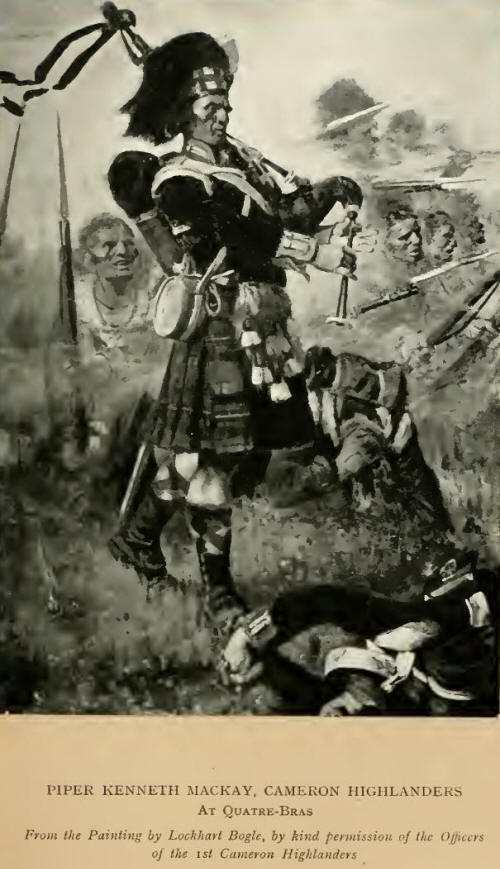|
Even pipers fall into the hands
of the enemy occasionally, but they were never allowed to take their
instruments with them into captivity. Gradually, as "comforts," pipes
were sent out to individual officers and men and the following letter
from an officer of the Gordon Highlanders who was at Friedberg Camp,
indicates how popular pipe music became among his fellow-prisoners of
the Allied armies.

"FRIEDBERG, 11/1/1917.
Though
only a young player I play here every day and do not find people too
hostile to me. The Russians, French and even the Germans greet me with
great interest and seem to find pleasure in listening to me— though as I
said I am no great player the most unsympathetic are always to be found
among the ranks of the " Sassenach." I learnt to play in 1911, on
joining my Regiment, under George MacLennan, who was Pipe-Major at that
time. While on leave in Edinburgh I used to have lessons with his
father—Jno. MacLennan. Up till now I have only attempted "The Glen is
mine" and "Struan Robertson" in Piobaireachd, but having been thoroughly
taught by the MacLennans I naturally follow their way of thinking'.
Yesterday I played to a Russian who is a very good player of the piano.
He was delighted with the Pipes and I conid not play too many tunes for
him. Strathspeys and Reels are greatly appreciated by all our Russian
friends. Last St. Andrew's Day we organized an Exhibition of dancing
which was a complete success. As the Scottish Colony here is so small we
asked the Russians to come and. help its. This they did right Nvell with
dances and songs, the music being provided, in both cases, by
"Balalaika," or Russian national instrument. For our part we danced two
foursome Reels (dancing two different sets of steps), a Sword Dance and
a Highland Schottische. In the latter dance we each took a Russian as a
partner, they having been trained up for the event. We sang " Bonnie
Dundee," "Lassies of Scotland," "MacPherson," and finished up with "Auld
Lang Syne."
For the Reels
my Russian friend provided the music on the piano. Our costume was of
course improvised. Kilt, shoes and hose we had, we wore white shirts
with lace cuffs, a strip of tartan fastened with a brooch at the
shoulder to do duty as a plaid and a black velvet band with a lace
ruffle, falling down in front, round our necks. Our sporans, with the
exception of one which was made out of a local rabbit, all came from
home. I had several pretty compliments paid to me by the Russians and
French, both on our costume and dancing. Five of us took part
altogether. I wonder if it would be too much to ask you to send me
instructions for dancing the "Lochaber Broadswords" and the "Seann
Triubhas," in case we have the misfortune to pass another St. Andrew's
Day here in Germany. If we do we shall give another Exhibition and I
would like to be able to vary it. I only know 12 Strathspey steps and 8
Reel steps. Since I have been a prisoner I have taught over 30 people to
dance the Reel—including two Frenchmen and one Russian, and at present I
have five pupils on the chanter. We are ifi Scots here, so can you say
we are losing our national distinctions? I have only told you this
because I thought it would interest you."
In Holland, in the internment camps, an organised
pipe band was instituted by the writer of the above letter, and
consisted of thirteen pipers of whom two were pipe majors.
|
